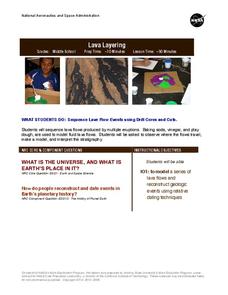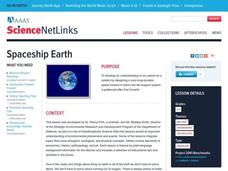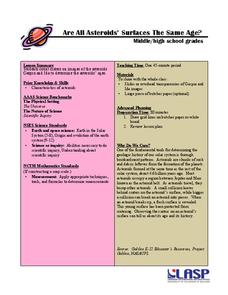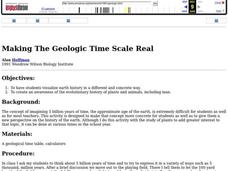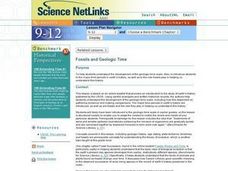NASA
Lava Layering
Take the old baking soda and vinegar volcano to the next level by using it to study repeated lava flows over time, examine geologic features on Earth and Mars, and speculate about some of the formations on Mars.
Pace University
Grades 9-12 Earth Science
How has Earth changed over time? Pupils explore the topic in a differentiated instruction unit on the geological time scale. After a pre-assessment to gauge knowledge, class members divide into groups based on their ability levels and...
Curated OER
Making The Geologic Time Scale Real
Students construct a geologic timeline the size of a football field. They work in small groups to calculate the yardage for significant events in the Earth's history and then as a class pace out all of the events.
Virginia Department of Education
Determining Absolute Age
How can radioactive decay help date old objects? Learners explore half-life and radioactive decay by conducting an experiment using pennies to represent atoms. Young scientists graph data from the experiment to identify radioactive decay...
Curated OER
Spaceship Earth
Students develop an understanding of our planet as a system by designing a very-long-duration space mission in which the life-support system is patterned after that of earth.
Curated OER
The History of Rock and Roll
Seventh graders examine how the different layers of rock show the history of the Earths surface. In this rock lesson students divide into groups and complete an activity using clay.
Curated OER
Relative Dating - Telling Time Using Fossils
Students use fossil range charts to explain relative dating. They graph for ammonites, marine organisms that went extinct at the same time as dinosaurs.
Curated OER
Photo-Documenting Earth Art
Young scholars study Earth Art Sculpture and its historic perspectives. They study important Earth Art sculptors, notably Andy Goldsworthy and view works of important Earth Artists. They explore the basic use of digital cameras and...
Curated OER
History Close to Home: Creating Your Own Special Museum
Students create their own museum exhibit. In this museum creation lesson plan, students research their local history so they can decide on a theme for their exhibit and what objects they will use in order to design a museum exhibit. A...
University of Colorado
Are All Asteroids' Surfaces the Same Age?
Did you know scientists can tell the age of an asteroid by looking closely at its craters? This final instructional activity of a six-part series focuses on two asteroids, Gaspra and Ida, in order to demonstrate the concept of dating...
Curated OER
Dinosaur I Finding And Dating
Students investigate how long dinosaurs lived on Earth and how that compare to how long man has been on Earth. They discover how scientists excavate fossils.
Curated OER
Mapping of the Earth's Past
Young scholars create a scale model time linen of the Earth's 4.6 billion year history. They calculate a scale that can fit on a very long register tape then label each geologic era. They use text books to annotate each era with major...
Curated OER
Measuring the Earth (Eratoshenes' method)
Sixth graders engage in problem solving, communicating, reasoning, and connecting to represent and solve problems, using geometric models.
Curated OER
The Finer Things in Life
Momoyama and Edo are periods in Japanese history that can be defined culturally and artistically. Learners explore and discuss how the samurai used sword guards and grip enhancers. Pupils read the story "The Inch-High Samurai," examine...
Curated OER
Dating Popcorn
Students simulate the dating process with popcorn. In this geology lesson, students discuss how geologist find the age of rocks by gauging the amount of decay of radioactive elements. They have 6 bags of popcorn and each group microwaves...
Curated OER
Europe – Religion and Reformation
Ninth graders examine the Reformation. In this European history lesson, 9th graders explore the 95 theses of Martin Luther and discuss the reaction of the Roman Catholic Church to his ideas. Students then take a quiz based on the lesson.
Curated OER
Geologic Time: Relative and Absolute Dating
High schoolers investigate relative and absolute dating; determine the difference between the two dating systems; and apply this knowledge by creating a geologic timetable of their own.
Curated OER
Dating Sedimentary Strata
Students investigate how the age of sedimentary strata is determined. In this sedimentary strata lesson, students work through problems that show that geological history covers millions of years. They distinguish between relative and...
Curated OER
History in the Painting
Students examine the topic of art history. They identify objects that were created long ago and the artists that made them. They create a tile design of their own to be displayed at school.
Curated OER
Role Playing in North America: Mid 1600s-Mid 1700s
Eighth graders apply their knowledge of North American history from the mid 1600's through the mid 1700's to a role-playing scenario. In small groups they plan, write, and perform a dramatic skit of a group that was affected by events in...
Curated OER
Making The Geologic Time Scale Real
Students are assigned significant geologic events in Earth's history. They convert the date of the events into distances and then space themselves (on an outside playing field) away from other groups, to represent time between various...
Curated OER
Science NetLinks: Fossils and Geologic Time
Students investigate the development of the geologic time scale. Also, to introduce them to the major time periods in earth's history, as well as to the role fossils play in helping us understand this history.
Curated OER
Fossils and Geologic Time
Students explore the development of the geologic time scale. They examine the major time periods in earth's history. Students discuss the role fossils play in helping us understand history.
Howard Hughes Medical Institute
Lesson 2: Gorongosa National Park
How has Gorongosa National Park changed over time? Discover the park's rich history, dating back to primitive human times, through an interactive timeline and scientific reading. The second installment in an eight-part series explores...
